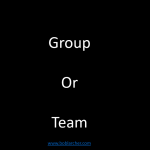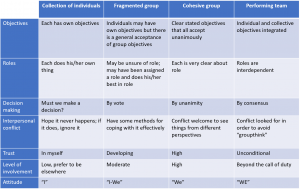When is a team not a team?

Collections of individuals masquerading as teams within organisations has never been uncommon; so, when is a team not a team?
The answer is actually more often than not; many of the project teams, the management teams, the design teams, the production teams and the sales teams that everyone refers to do not (often by a long stroke), fulfil the definition attributed to a team – especially to those which are, apparently, empowered, liberated, etc.
A team is, according to Jon Katzenbach (in his book the wisdom of teams), “A small number of people with complementary skills who are equally committed to a common purpose, goals and working approach for which they hold themselves mutually accountable”
“Small” is rather subjective and there is clearly no “ideal” team size; the size will depend on its charter; what it is expected to be accountable for within the organisation.
John E. Jones who created the Group Development Assessment identified four criteria of “teamness”:
- The team has a charter, it is an official part of the organisation, charged with definable tasks.
- Team members’ work tasks are interdependent; they need to collaborate in order to do their work.
- Team members are committed to working together cooperatively; they are ready and willing to do whatever it takes to carry out the team’s responsibilities well.
- The team is held accountable a s functional unit by the organisation; there is no place to hide and the fortunes of individual members rise and fall as the team performs its functions.
In another of his books (teams at the top) Katzenbach developed what he calls his “Litmus Test” for teams:
- Does the team have collective work products dependent on the joint application of multi-person skills?
- Does leadership move around within the team?
- Is there mutual (as well as individual) accountability for the team’s overall results?
Clearly, a team is more than simply a collection of individuals doing something together; it is more, much more. The table below summarises some of the key differences between a collection of people, a group and a team:

Putting a collection of individuals together and giving them a name and a task to carry out may make them a team somewhere on the organisational chart. However, the reality is that becoming a real team takes both time and substantial active involvement of its’ members; it requires both mutual and individual accountability and it requires well-developed interpersonal skills.
If you want to read more about teams and how they can develop to become an “E2 team” watch out for my next articles